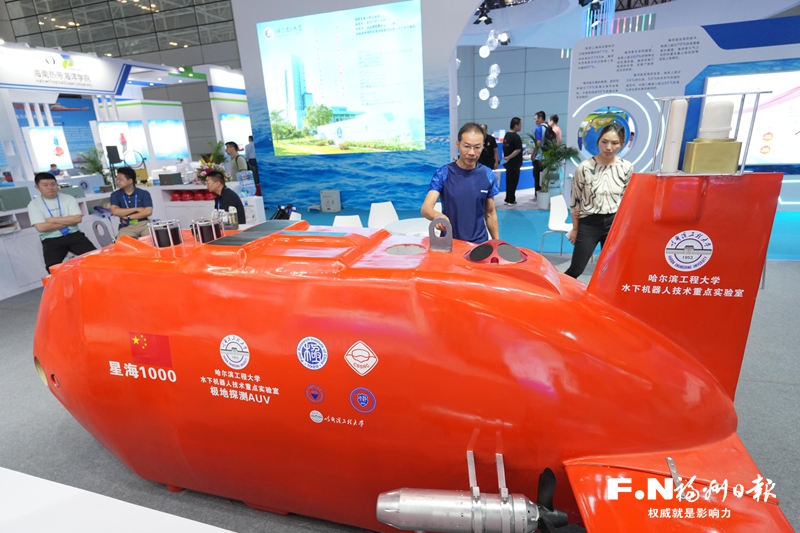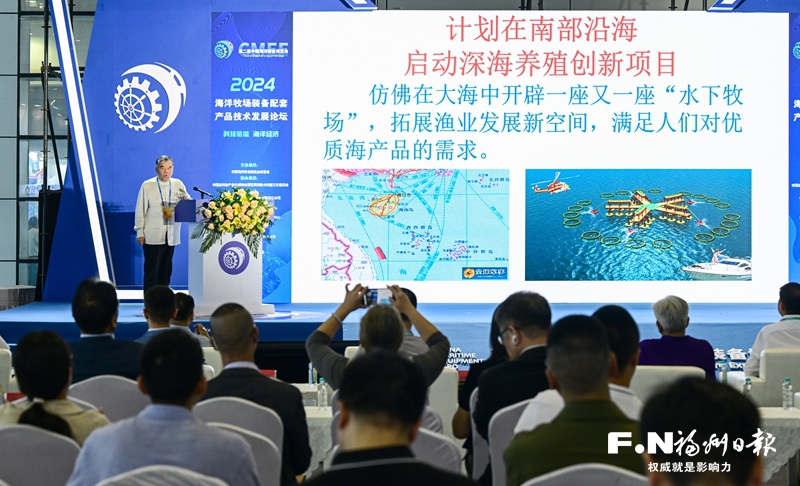The famous navigator Zheng He once said: “To make the country rich and powerful, the ocean must not be neglected. Wealth comes from the ocean, but danger also comes from the sea.” The ocean is a critical area for high-quality development strategy. In the boundless blue depths, a quiet dialogue between technology and nature is unfolding. How to safeguard our abundant “blue assets” and become the “vanguard” in ocean exploration has become a question that China is accelerating to address.
At the Second China Maritime Equipment Expo 2024, four innovative seminars focused on important topics of empowering the “deep blue era” through new quality productive forces: the innovative development of the marine cultural tourism industry, the development of the smart ocean industry, the technological development of marine ranching equipment and supporting products, and the future development of offshore energy. Experts, scholars, and industry leaders gathered to share their global perspectives, seeking innovation from the sea and continuously gathering the “deep blue power” for the construction of a maritime strong nation.
Marine Cultural Tourism
Take Seas as Veins and Promote Multi-industry Integration
Culture is a significant driving force behind economic development, and maritime culture holds important economic value. Experts believe that promoting the high-quality development of maritime culture and tourism, reshaping maritime civilization, and exploring maritime culture are essential prerequisites.
“Chinese maritime civilization is an important part of world maritime civilization,” said Liu Xunhua, Executive Vice Chairman and Secretary-General of the National Marine Education Research Alliance. He believes that maritime civilization is the foundation of maritime culture. To reshape maritime civilization, it is necessary to build diverse methods of maritime cultural communication and strengthen research and investment in maritime civilization and culture.
Fujian, as a key starting point of the ancient Maritime Silk Road, has created a brilliant maritime culture and left behind valuable maritime cultural heritage. “The Mazu beliefs, the King Boat procession, and Gulangyu Island, among others, are all contributions of Fujian to maritime culture,” said Su Wenjing, Director and Chief Expert of the Fujian Marine Culture Research Center. These maritime cultural heritages have unique advantages in the construction of contemporary Chinese maritime culture.
Regarding the development of the marine cultural industry in the new era, Su Wenjing believes that the key directions are refining and applying maritime cultural symbols, as well as exploring the cultural core of maritime industries. She calls for the formulation of practical protection measures and reasonable development and utilization plans to achieve sustainable development of marine cultural resources.
The maritime cultural and tourism industry is not only a carrier for building maritime culture but also, with its unlimited potential, an important engine driving the development of new quality productive forces. Wei Yan, the project leader of Shandong’s Blue Ocean Economy Comprehensive Complex “Ocean Harvest No.1,” and Gu Pengcheng, the Board Secretary of China Cruise Technology Development Co., Ltd., illustrated the emergence of maritime culture and tourism as a new economic growth point through the examples of “Ocean Harvest No.1” and “Adora Magic City”.
As a new benchmark for maritime cultural tourism, “Ocean Harvest No.1” has created an “all-in-one maritime resort complex” that integrates dining, accommodation, transportation, sightseeing, shopping, and entertainment. Wei Yan stated that the project has achieved deep integration of primary and tertiary industries, pioneering a new model for the development of blue grain storage and blue cultural tourism, and creating a replicable and scalable new path.
“The demand for cruise tourism in China is strong, and the golden era of cruising has arrived,” said Gu Pengcheng, who is confident about the cruise economy. At the same time, he believes that cruises are an imported product, and it is crucial to build a “Chinese model” that integrates the cruise economy with cultural tourism. He proposes the construction of leading enterprises to guide the cruise industry’s ecosystem, developing high-level, fully autonomous operational capabilities, and deeply exploring China’s industrial culture, maritime culture, Silk Road culture, and intangible cultural heritage to provide passengers with an experience that integrates local culture.

Harbin Engineering University Presents the “Xinghai 1000” Polar Exploration Unmanned Submersible.Reporter: Bao Hua / Photography
Smart Oceans
Sailing with Digital Intelligence, Dreaming of the Deep Blue
What is a smart ocean? What are the “novel and unique” features of smart oceans? How is China’s smart ocean industry advancing into the “deep waters”? At the Smart Ocean Industry Development seminar, blue energy surged as experts and scholars shared their insights, guiding everyone toward a smarter, more sustainable marine future.
“Empowering the Future with Innovation, Winning the World with Digital Intelligence” – this is the expectation of Fang Shujia, former Chief Engineer and Researcher of the China Shipbuilding Industry Group Co., Ltd., for new technologies that empower marine rights protection. Focusing on the shared intelligence goal of ocean-going vessels and rights protection ships, he believes the smart ocean and technology research should be accelerated so that autonomous driving, cargo handling, maintenance, and sewage treatment can all have “intelligent factors.” At the same time, the shipbuilding industry needs to improve its “power” by using “innovation + data” to empower China’s efforts in building a strong modern maritime rights protection force.
From ancient times to the present, human exploration of the deep sea is far from exhausted. New forms of productive forces, represented by underwater vehicles and underwater robots, have become a powerful engine driving us forward.
“Unmanned underwater vehicles can replace humans in performing tedious, harsh, and dangerous tasks. They are the core equipment for managing the ocean, realizing ocean entry, ocean exploration, and ocean utilization,” said Professor Du Xiaoxu from Northwestern Polytechnical University, a national-level talent. Through his explanation, the mysteries of the nation’s major equipment are revealed.
According to Du Xiaoxu, the priority development direction for underwater unmanned systems should be clustering and distribution. The goal is to upgrade from a single platform with specific functions to a cluster-based system. “Multidisciplinary optimization design, structure and materials design, propulsion and power technologies, etc., are all forward directions for underwater vehicles.”
To venture into the deep sea, both hardware and software are required. The integrated open platform for marine engineering digital intelligence accelerated around the concept of “digital intelligent oceans”, is a new achievement presented by Zhang Xiaoyang, Deputy Director of the Digital Intelligent Ocean and Smart Marine Engineering Technology Research Center at the China Ocean Engineering Research Institute.
“As marine engineering continues to develop towards larger-scale and deeper offshore projects, effectively managing and applying the entire lifecycle of marine engineering and equipment through digital intelligence is crucial," said Zhang Xiaoyang. By integrating technologies such as the Internet of Things (IoT), big data, cloud computing, and artificial intelligence, the platform can be widely applied in fields like deep-sea oil and gas development, offshore wind power, and marine mineral resource exploration. “With the ‘small steps, quick progress’ of domestic industrial software, we hope to contribute to continuous breakthroughs in the construction of a strong marine nation.”

Marine Ranching Equipment and Supporting Product Technology Development seminar.Reporter:Shi Meixiang / Photography
Marine Ranching
Blue Granary, Fine Cultivation
In recent years, China has accelerated the construction of a “blue granary”, vigorously developing modern marine ranching to derive food from the ocean. How can deep-sea aquaculture equipment be developed on a large scale? How can intelligent aquaculture be realized? At the Marine Ranching Equipment and Supporting Product Technology Development seminar, industry experts and enterprise representatives discussed the far-reaching plans for the development of deep-sea aquaculture and related equipment industries.
From fish farms to deep-water cages and aquaculture vessels, marine aquaculture is gradually advancing into deeper, farther seas. Where does the competitiveness of deep-sea aquaculture lie?
“Developing deep-sea aquaculture is a strategic issue for ensuring national food security, achieving sustainable development of the marine fishery economy, and building a marine ecological civilization,” said Xia Qi, Senior Engineer at the Institute of Electrical Engineering, Chinese Academy of Sciences. As a sustainable mode of marine seafood production, deep-sea aquaculture offers a new strategic choice for global food security and ecological protection.
In the view of Lv Delong, Senior Engineer at the Institute of New Technology Promotion and Research in the Armaments Industry, deep-sea aquaculture projects have great development potential. “Deep-sea aquaculture platforms seem to create ‘underwater ranches’ in the vast ocean, expanding new space for fishery development and meeting people’s demand for high-quality marine products,” Lv said. “These platforms are not only modern fishery aquaculture facilities but also offer a completely new marine ranching experience for tourists. They can also provide local residents with more job opportunities and sources of income.”
Currently, more and more enterprises and research institutions are exploring various ways to develop suitable fishing spaces in the deep, far-off seas, striving to obtain food from the ocean and continuously improve the stability and supply of aquatic products.
In the face of this trend, Zhang Tianshi, Associate Researcher at the Yellow Sea Fishery Research Institute of the Chinese Academy of Fishery Sciences, suggests that in the construction of marine ranches and the ongoing development of deep-sea aquaculture, information technology, intelligence, and modernization in the transformation and upgrading of smart fishery should be implemented at every stage to gradually realize intelligent aquaculture.
Equipment paves the way for ocean harvesting and exploring. “Currently, common domestic gravity-type cages and some large equipment face issues such as poor resistance to wind and waves, difficult construction, high operation and maintenance costs, and poor economic feasibility,” said Wang Huai’an, Head of the Technology Department and Senior Engineer at Hebei Huatong Wires and Cables Group Co., Ltd. Based on the lessons learned from various deep-water aquaculture equipment, the company has adopted a fully submerged and floating method, replacing floating or bottom-mounted systems, which can reduce construction and operation costs.
Offshore Energy
Prospering by the Sea, Blending Blue and Green
Since the beginning of the 14th Five-Year Plan, global investments in offshore oil and gas development have continued to rise, offshore wind power growth has returned to a positive trajectory, and the development of offshore hydrogen energy, tidal energy, and other marine energies has accelerated. China’s offshore energy industry is entering an unprecedented period of development opportunities.
What is the significance of offshore energy development? What are the trends in industry development? How can we promote the sustainable development of the offshore energy industry? Experts and scholars, through in-depth exchanges and intellectual collisions, are providing ideas for the industry’s development.
“The ocean is the largest hydrogen resource on Earth, accounting for 97% of the planet’s water resources. Looking to the ocean for water is an important strategic direction for the future development of hydrogen energy,” said Li Yi, Supervisor and Deputy Chief Engineer at Dongfang Electric (Fujian) Innovation Research Institute Co., Ltd. He emphasized that to take the lead in the hydrogen energy race, the focus must be on the ocean.
In May of last year, at the Xinghua Bay offshore wind farm in Fuqing, Dongfang Electric Corporation, in collaboration with Academician Xie Heping’s team, successfully conducted a marine pilot test of the technology for direct electrolysis of seawater to produce hydrogen, solving the century-old problem of seawater direct electrolysis and showcasing China’s zero-carbon energy solution to the world.
Clean and low-carbon energy is the inevitable trend of global energy transformation, and today, offshore new energy and the new economy are experiencing explosive growth. Li Hongtao, Deputy Director of the Offshore Engineering Technology Center of the China Classification Society, pointed out that tidal energy, current energy, and wave energy all have corresponding scientific research and demonstration applications. Exploring the construction of offshore “energy islands” that integrate offshore photovoltaics, offshore wind power, other marine energies, and green hydrogen production is an important direction for the future development of marine resources.
As a mature clean energy source, how should offshore wind power develop in the future? Li Hongtao believes that industrial collaboration and multi-energy complementarity will become the development trend of offshore wind power, with scaling, large-scale, lightweight, and intelligent technologies being effective ways to reduce costs and increase efficiency.
“The South-to-North Water Diversion, West-to-East Power Transmission, and North-to-South Grain Transport are China’s resource allocation patterns. The vigorous development of offshore energy could change the original patterns,” said Gao Xifeng, Director of the Ocean Energy and Smart Construction Research Institute at Tianjin University of Technology. He emphasized the need to accelerate research on technologies for the joint development of wind, solar, wave, and tidal energies, as well as to create integrated projects for offshore oil and gas, wind, solar, fishing, tourism, carbon storage, and water. He also advocated for the establishment of smart green energy river-ocean laboratories to promote the sustainable development of the offshore energy industry.(Reporters:Sun Man, Lin Han, and Fu Yijing / Text; Bao Hua and Shi Meixiang / Photography)







